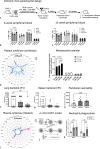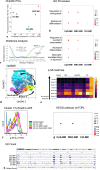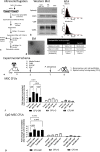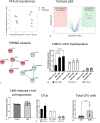Mesenchymal Stromal Cells Facilitate Neutrophil-Trained Immunity by Reprogramming Hematopoietic Stem Cells
- PMID: 37797588
- PMCID: PMC10622164
- DOI: 10.1159/000533732
Mesenchymal Stromal Cells Facilitate Neutrophil-Trained Immunity by Reprogramming Hematopoietic Stem Cells
Abstract
Novel therapeutics are urgently needed to prevent opportunistic infections in immunocompromised individuals undergoing cancer treatments or other immune-suppressive therapies. Trained immunity is a promising strategy to reduce this burden of disease. We previously demonstrated that mesenchymal stromal cells (MSCs) preconditioned with a class A CpG oligodeoxynucleotide (CpG-ODN), a Toll-like receptor 9 (TLR9) agonist, can augment emergency granulopoiesis in a murine model of neutropenic sepsis. Here, we used a chimeric mouse model to demonstrate that MSCs secrete paracrine factors that act on lineage-negative c-kit+ hematopoietic stem cells (HSCs), leaving them "poised" to enhance emergency granulopoiesis months after transplantation. Chimeric mice developed from HSCs exposed to conditioned media from MSCs and CpG-ODN-preconditioned MSCs showed significantly higher bacterial clearance and increased neutrophil granulopoiesis following lung infection than control mice. By Cleavage Under Targets and Release Using Nuclease (CUT&RUN) chromatin sequencing, we identified that MSC-conditioned media leaves H3K4me3 histone marks in HSCs at genes involved in myelopoiesis and in signaling persistence by the mTOR pathway. Both soluble factors and extracellular vesicles from MSCs mediated these effects on HSCs and proteomic analysis by mass spectrometry revealed soluble calreticulin as a potential mediator. In summary, this study demonstrates that trained immunity can be mediated by paracrine factors from MSCs to induce neutrophil-trained immunity by reprogramming HSCs for long-lasting functional changes in neutrophil-mediated antimicrobial immunity.
Keywords: Epigenetics; Hematopoietic stem cells; Neutrophils; Toll-like receptor 9; Trained immunity.
© 2023 The Author(s). Published by S. Karger AG, Basel.
Conflict of interest statement
The authors have no conflicts of interest to declare.
Figures




References
-
- GBD 2016 Lower Respiratory Infections Collaborators . Estimates of the global, regional, and national morbidity, mortality, and aetiologies of lower respiratory infections in 195 countries, 1990-2016: a systematic analysis for the Global Burden of Disease Study 2016. Lancet Infect Dis. 2018 Nov;18(11):1191–210. 10.1016/S1473-3099(18)30310-4. - DOI - PMC - PubMed
Publication types
MeSH terms
Substances
Grants and funding
LinkOut - more resources
Full Text Sources
Research Materials
Miscellaneous

